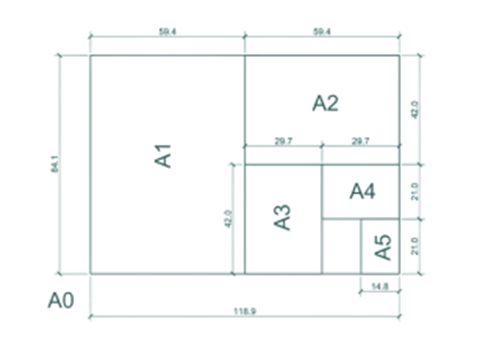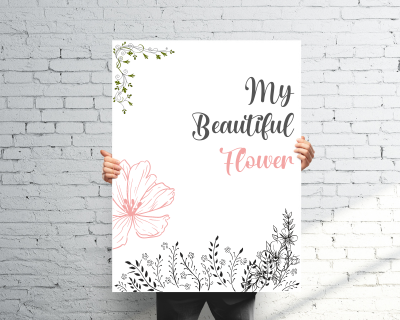5 commonly used poster sizes: essential knowledge for designers|What are the differences between different poster sizes?
As an important medium for conveying information and attracting audience attention, posters can be used for commercial promotion, interior decoration, and posting notices. Choosing the appropriate poster size is crucial for conveying information and creating an atmosphere. This article will detail commonly used poster sizes, including A0, A1, A3, A4, and A5, and provide some terminology related to poster sizes for designers to understand their impact on overall design.
International Paper Standard (ISO 216)
When it comes to poster sizes, it's important to understand the International Paper Standard (ISO 216). It is a globally recognized paper size standard that is widely used in many countries and regions. This standard was developed by the International Organization for Standardization (ISO) to establish a series of standardized paper sizes for international consensus on paper size.
The most common paper size in the ISO 216 standard is the A series. A series paper sizes are designed according to a fixed aspect ratio, with the most common size being A4, which is commonly used for letters, documents, reports, and promotional flyers.
A series paper sizes are numbered according to a simple rule. Specifically, the A0 paper size is 841 millimetres by 1189 millimetres, and the A1 paper size is half of A0, A2 is half of A1, and so on, down to A10.

Poster Size Terminology
In addition to the commonly heard A0, A1, A3, and other sizes, sometimes we may come across unfamiliar poster size terminology online, such as 1K, 2K, and 8K. What do they mean? It turns out that these are printing industry terminology in Taiwan (originating from Japanese specifications). They divide paper into “Shi-roku-ban” and “Kiku-ban" 46 ban is equivalent to our B size paper, while Kiku-ban (also known as G, taken from the pinyin of "ju") corresponds to A size paper. "K" means "kai," so ju 4 kai in Taiwan is also called "G4K" or "4K."
Kiku-ban Poster Size
| Poster size | Standard size | Die-cut size | explanation |
| G1K | 872*621mm | 842*594mm | Refers to the dimensions of the paper when fully unfolded. |
| G2K | 621*436mm | 594*421mm | Refers to the size of a full-size paper cut in half once. It is often used to make books, manuals, etc. |
| G3K | 787*363mm | 751*345mm | Refers to the size of a full-size paper cut in half four times. It is often used to make brochures or leaflet promotional materials. |
| G4K | 436*310mm | 421*297mm | Refers to the size of a full-size paper cut in half four times. It is often used to make brochures or leaflet promotional materials. |
| G8K | 310*218mm | 297*210mm | Refers to the size of a full-size paper cut eight times. This size is commonly used to make brochures, brochures and small brochures. |
| G16K | 218*155mm | 210*148mm | Refers to the size of a full-size paper cut sixteen times. |
| G32K | 155*109mm | 148*105mm | Refers to the size of a full-size paper after 32 cuts. |
| G64K | 109*77mm | 105*74mm | Refers to the size of a full-size paper after 64 cuts. |
Shi-roku-ban Poster Size
| Poster size | Standard size(mm) | Die-cut size(mm) |
| 1K | 1091*787mm | 1042*751mm |
| 2K | 787*545mm | 751*521mm |
| 3K | 787*363mm | 751*345mm |
| 4K | 545*393mm | 521*375mm |
| 5K | 454*318mm | 424*303mm |
| 8K | 393*272mm | 375*260mm |
| 16K | 272*196mm | 260*187mm |
| 32K | 196*136mm | 183*130mm |
| 64K | 136*98mm | 130*93mm |
Since there are no 3K, 5K and G3K in Hong Kong, the ISO 216 form commonly used in Hong Kong is:
A series poster sizes
| Poster size | Standard size | Die-cut size |
| A1 | 872*621mm | 842*594mm |
| A2 | 621*436mm | 594*421mm |
| A3 | 436*310mm | 421*297mm |
| A4 | 310*218mm | 297*210mm |
| A5 | 218*155mm | 210*148mm |
| A6 | 155*109mm | 148*105mm |
| A7 | 109*77mm | 105*74mm |
B series poster sizes
| Poster size | Standard size | Die-cut size |
| B1 | 1091*787mm | 1042*751mm |
| B2 | 787*545mm | 751*521mm |
| B3 | 545*393mm | 521*375mm |
| B4 | 393*272mm | 375*260mm |
| B5 | 272*196mm | 260*187mm |
| B6 | 196*136mm | 183*130mm |
| B7 | 136*98mm | 130*93mm |
As far as opening posters is concerned, due to the need to display a large number of elements, text and design, a larger B series poster size is generally used in order to show the details and there will be more space when printing; The A series is more commonly used in portable prints such as books. In addition, there are some size specifications of oversized posters, generally expressed in cm, such as:
| Poster size | Standard size | Die-cut size |
| Oversized poster | 100*77cm | 100.6*70.6cm |
Design trivia: how to choose a good size?
Poster size is one of the important factors affecting poster design and communication effect, which will have an impact on conveying information, sense of space and composition. Imagine if you're promoting a concert, using daisy-sized posters can provide more space to display photos of performers, detailed time and location information, and playlists. Such large-sized posters can attract attention and make it easier for people to access the information they need; but if you're promoting a small exhibition, a 4K size poster might be more appropriate. It provides enough space to display images of the main works and presents the exhibition information succinctly in a limited space. When designing a poster, choosing the appropriate size for the specific scene and purpose will help achieve the best visual and communication results.
If you choose an inappropriate poster size when printing, it may lead to the content cannot be clearly presented, choosing too large a poster size may exceed the capacity of the printing press, resulting in a decline in the quality of the print, some designers in order to force a large size of the poster, may stretch the image or enlarge the image, resulting in blurry, pixelated or distorted image, but affect the quality of the overall print.

For posters with rich images, you should choose a larger poster size. If you choose too small a poster size and try to cram a lot of content into a limited space, the text and images become blurry and cannot clearly present the details, which makes it difficult for the audience to read important information and affects the communication effect. Too small a size may also not fit the image you want to showcase, making the whole design look crowded or unbalanced, reducing the visual appeal and professionalism of the poster. Choosing a larger poster size when designing can facilitate designers to present the details of the image clearly and with a more spatial sense.

Three key points for choosing poster size:
1. Conveying information
Poster size is directly related to the amount and content of information you want to convey. Larger posters can accommodate more text, images, and charts, which is advantageous for conveying rich information. For example, a poster size of Kiku-zen can attract people's attention at exhibitions or public places and convey detailed product or event information.
2. Sense of space
Poster size is crucial for creating a sense of space and visual effects. Larger posters can create a stronger visual impact and shock. In contrast, smaller posters are more suitable for close viewing or limited spaces. For example, a smaller poster can be placed on a display case in a store for customers to view up close and attract their attention.
3. Composition
Poster size is very important for the balance of composition and design. Different sizes can affect the layout and arrangement of images and text on the poster. For larger posters, you can use larger images and text to create eye-catching visual effects. Conversely, smaller posters require more concise and simple designs to ensure clear communication of information. For example, for a smaller poster, you may need to use smaller fonts and shorter slogans to fit the limited space.
5 commonly used poster sizes
| Poster size | Standard size | Die-cut size (+3mm) |
| Small poster | 130*180mm | 136*186mm |
| Promotional posters | 500*700mm | 506*706mm |
| Movie poster | 780*1000mm | 786*1006mm |
| Pull-up poster | 800*2000mm | 806*2006mm |
| General poster | 190*250mm | 196*256mm |

